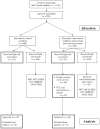Reducing depression among at-risk early adolescents: three-year effects of a family-centered intervention embedded within schools
- PMID: 18729671
- PMCID: PMC2813766
- DOI: 10.1037/0893-3200.22.3.574
Reducing depression among at-risk early adolescents: three-year effects of a family-centered intervention embedded within schools
Abstract
The Adolescent Transitions Program (ATP) is a family-focused multilevel prevention program designed for delivery within public middle schools to target parenting factors related to the development of behavior problems in early adolescence. The current study examines the effects of the ATP on the development of youth depressive symptoms across early adolescence in a sample of 106 high-risk youths. Youths were recruited in 6th grade, and selected as high risk based on teacher and parent reports of behavioral or emotional problems. Depression symptoms were based on youth and mother reports in 7th, 8th, and 9th grades. Receipt of the family-centered intervention inhibited growth in depressive symptoms in high-risk youths over the 3 yearly assessments compared with symptoms in high-risk youths in the control group. Results support the notion that parental engagement in a program designed to improve parent management practices and parent-adolescent relationships can result in collateral benefits to the youths' depressive symptoms at a critical transition period of social and emotional development.
Figures
References
-
- Achenbach TM. Manual for Child Behavior Checklist/4-18 and 1991 Profile. University of Vermont, Department of Psychiatry; Burlington, VT: 1991.
-
- Asarnow J, Goldstein M, Tompson M, Guthrie D. One-year outcomes of depressive disorders in child psychiatric inpatients: Evaluation of the prognostic power of a brief measure of expressed emotion. Journal of Child Psychology and Psychiatry. 1993;34:129–137. - PubMed
-
- Asarnow J, Scott C, Mintz J. A combined cognitive–behavioral family education intervention for depression in children: A treatment development study. Cognitive Therapy and Research. 2002;26:221–229.
-
- Birmaher B, Brent D, Kolko D, Baugher M, Bridge J, Holder D, et al. Clinical outcome after short-term psychotherapy for adolescents with major depressive disorder. Archives of General Psychiatry. 2000;57:29–36. - PubMed
-
- Botvin GJ, Baker E, Dusenbury L, Tortu S, Botvin EM. Preventing adolescent drug abuse through a multimodal cognitive–behavioral approach: Results of a three-year study. Journal of Consulting and Clinical Psychology. 1990;58:437–446. - PubMed




